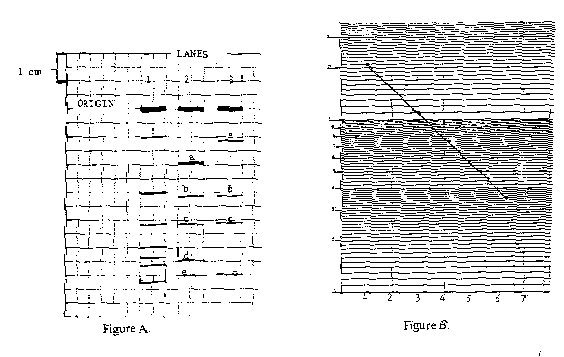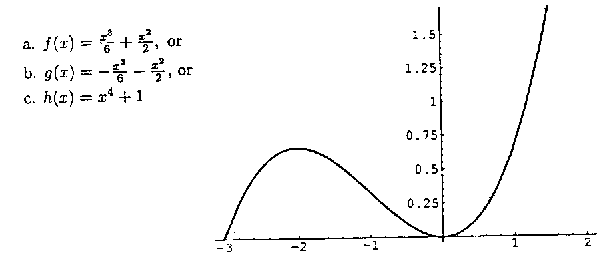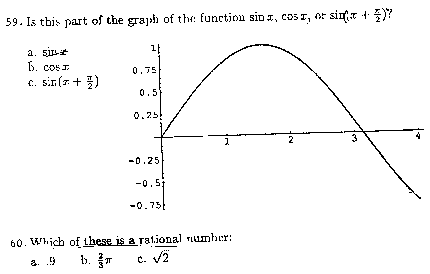 |
 |
|
| : Instruments : Curriculum Development | ||
|
|||||||||||||||||||||||||||||||||||||||||||||||||||||||||||||||||||||||||||||||||||||||||||||||||||||||||||||||||||||||||||||||||||||||||||||||||||||||||||||||||||||||||||||||||||||||||||||||||||||||||||||||||||||||||||||||||||||||||||||||||||||||||||||||||||||||||||||||||||||||||||||||||||||||||||||||||||||||||||||||||||||||||||||||||||||||||||||||||||||||||||||||||||||||||||||||||||||||||||||||||||||||||||||||||||||||||||||||||||||||||||||||||||||||||||||||||||||||||||||||||||||||||||||||||||||||||||||||||||||||||||||||||||||||||||||||||
Biology
INTERESTS AND SKILLS The first questions in this section ask you to rate your current skills for studying biology and chemistry at the college level.
FUTURE INTENTIONS The questions in this section are about your future plans—what you think you might be doing next year and beyond.
Now think about your long-term future, maybe ten years from now. Imagine you could be anything you want to be. What would you like to be doing? What field do you want to work in? What career would you like to have? PLEASE WRITE YOUR RESPONSE HERE ON THIS QUESTIONNAIRE. _____________________________________________________________________________ _____________________________________________________________________________ _____________________________________________________________________________
THE FOLLOWING INFORMATION IS NEEDED FOR THE STATISTICAL ANALYSIS OF THE RESULTS OF THIS SURVEY.
Refer to the following for Questions 30-33 A researcher was interested in learning about the size of a DNA molecule in a bacteriophage (virus). To do this, she used enzymes, called restriction endonucleases, to cut the DNA at specific sites. The treated DNA is referred to as "digests." She took her digests and ran them on an electrophoretic gel to observe different fragment lengths. By calculating the different lengths of the digests, she can obtain an overall picture of the DNA size. Refer to Figure A. It is 1 cm graph paper on which the research recorded the positions on the different bands of DNA to mimic their appearance on the gel (bands a-e). She loaded the DNA to be analyzed onto the gel at the site, labeled on the graph paper as "origin." When placed in an electrophoretic field, the digests run from top to bottom. In lane 1 she placed a DNA standard for which, electrophoretic mobility of DNA of specific sizes is known. In lane 2 she labeled DNA to be studied. In lane 3 she used the same phage DNA but incubated it differently. She plotted her results on semilog paper shown in Figure B. Let's see if you can figure out some sizes of the phage DNA. Lane 1 of a DNA electrophoresis gel (Fig. A) shows bands of a known DNA standard with following fragment sizes:
3b Post-test
INTRODUCTION TO BIOLOGY-CHEMISTRY SURVEY
|
|||||||||||||||||||||||||||||||||||||||||||||||||||||||||||||||||||||||||||||||||||||||||||||||||||||||||||||||||||||||||||||||||||||||||||||||||||||||||||||||||||||||||||||||||||||||||||||||||||||||||||||||||||||||||||||||||||||||||||||||||||||||||||||||||||||||||||||||||||||||||||||||||||||||||||||||||||||||||||||||||||||||||||||||||||||||||||||||||||||||||||||||||||||||||||||||||||||||||||||||||||||||||||||||||||||||||||||||||||||||||||||||||||||||||||||||||||||||||||||||||||||||||||||||||||||||||||||||||||||||||||||||||||||||||||||||||
| USE OTHERS' WORK | |||||||
|
|
|
|
|
|
|
||
|
|
|
|
|
|
||
|
|
|
|
|
|
||
|
|
|
|
|
|
||
|
|
|
|
|
|
||
|
|
|
|
|
|
| How well can you... PRODUCE YOUR OWN WORK |
|||||||
|
|
|
|
|
|
|
||
|
|
|
|
|
|
||
|
|
|
|
|
|
||
|
|
|
|
|
|
||
|
|
|
|
|
|
||
|
|
|
|
|
|
||
|
|
|
|
|
|
||
|
|
|
|
|
|
||
|
|
|
|
|
|
- Which of the following sounds closest to your attitude:
- Math turns me off; I start yawning as soon as someone talks about it.
- Math turns me on; a math problem wakes me up; I do most of math alone.
- I am scared of math; I just don't have the self-confidence.
- I try to follow everything the instructor says, but I still don't get the point of my math class.
- Math classes are challenging but I enjoy them and find them conducive to discussion; I work with others a lot.
- Skip this question if you are comfortable with math; if
you aren't mark as many items as apply to you.
- Hardest for me:
- are formulas. I wish there were more pictures.
- are pictures. I wish there were more time/guidance devoted to interpreting them.
- Are word problems, i.e., transferring data (a horse's speed is 2 meters per second) into symbols (s=2t m)
- is motivation. I would love to do the math problems if they were related to life (i.e., how tall does a plant grow in a month.)
- is memorizing theorems, facts to be used.
- Hardest for me:
| How much do you AGREE or DISAGREE with each of the following statements? |
|||||||
|
|
|
|
nor disagree |
|
|
||
|
|
|
|
|
|
||
|
|
|
|
|
|
||
|
|
|
|
|
|
EVALUATIONS OF BIOLOGY 108
| TO WHAT EXTENT DID BIOLOGY 108 | |||||||
|
|
great extent |
|
|
|
|
||
|
|
|
|
|
|
||
|
|
|
|
|
|
||
|
|
|
|
|
|
||
|
|
|
|
|
|
| TO WHAT EXTENT DID CHEMISTRY 102 | |||||||
|
|
great extent |
|
|
|
|
||
|
|
|
|
|
|
||
|
|
|
|
|
|
||
|
|
|
|
|
|
||
|
|
|
|
|
|
| DID THE MATH LABS/PROJECTS: | |||||||
|
|
great extent |
|
|
|
|
||
|
|
|
|
|
|
||
|
|
|
|
|
|
||
|
|
|
|
|
|
||
|
|
|
|
|
|
Sometimes work goes better when we get support from others. Support can be concern, encouragement, or actual help. This semester, in Biology 108, how much SUPPORT did you get from each of the following?
|
|
|
|
|
|
|
||
|
|
|
|
|
|
||
|
|
|
|
|
|
||
|
|
|
|
|
|
||
|
|
|
|
|
|
Sometimes work goes better when we get support from others. Support can be concern, encouragement, or actual help. This semester, in Chemistry 102, how much SUPPORT did you get from each of the following?
|
|
|
|
|
|
|
||
|
|
|
|
|
|
||
|
|
|
|
|
|
||
|
|
|
|
|
|
||
|
|
|
|
|
|
FUTURE INTENTIONS
The questions in this section are about your future plans—what you think you might be doing next year and beyond.
| HOW LIKELY IS IT.... | |||||||
|
|
likely |
|
likely |
|
likely |
||
|
|
|
|
|
|
||
|
|
|
|
|
|
||
|
|
|
|
|
|
- If your advisor were to tell you it was unlikely you could
get into medical school, would you continue to take biology,
chemistry or math courses?
(a) yes (b) maybe (c) no
THE FOLLOWING INFORMATION IS NEEDED FOR THE STATISTICAL ANALYSIS OF THE RESULTS OF THIS SURVEY.
- What is your racial or national background?
- White
- Black/African American
- Hispanic
- Asian/Asian American
- Other _____________________________________________
- What language did you most often speak at home?
- English
- Spanish
- Chinese
- Arabic
- Other ______________________________________________
- What year are you in?
- FR
- SOPH
- JR
- SR
Refer to the following for Questions 46-49
A researcher was interested in learning about the size of a DNA molecule in a bacteriophage (virus). To do this, she used enzymes, called restriction endonucleases, to cut the DNA at specific sites. The treated DNA is referred to as "digests." She took her digests and ran them on an electrophoretic gel to observe different fragment lengths. By calculating the different lengths of the digests, she can obtain an overall picture of the DNA size.
Refer to Figure A. It is 1 cm graph paper on which the research recorded the positions on the different bands of DNA to mimic their appearance on the gel (bands a-e). She loaded the DNA to be analyzed onto the gel at the site, labeled on the graph paper as "origin." When placed in an electrophoretic field, the digests run from top to bottom. In lane 1 she placed a DNA standard for which, electrophoretic mobility of DNA of specific sizes is known. In lane 2 she labeled DNA to be studied. In lane 3 she used the same phage DNA but incubated it differently.
She plotted her results on semilog paper shown in Figure B. Let's see if you can figure out some sizes of the phage DNA.

Lane 1 of a DNA electrophoresis gel (Fig. A) shows bands of a known DNA standard with following fragment sizes:
| 21.0 | 11.0 | 7.4 | 5.8 | 5.0 | 4.2 | 3.5 | (in kilobases) |
- A standard curve is plotted on semilog paper in centimeters
(Fig. B).
The axis should be labeled:- X = size, Y = time
- X = number of kilobases; Y = centimeters
- X = distance (centimeters); Y = size (kilobases)
- X = time; Y = centimeters
- X = migration velocity; Y = distance (centimeters)
- The scale in Figure A is 2 squares = 1 centimeter. The
diagram of this electrophoretic gel extrapolated to the
graph demonstrates:
- the larger the fragment, the longer the distance it travels
- the smaller the fragment, the faster it moves
- the larger the fragment, the slower it moves
- the smaller the fragment, the longer the distance it travels
- the kinds of bases which the restriction enzymes separates
- In Figure B, the top left dot on the graph represents:
- a piece of DNA 21 kilobases long which has migrated 1 centimeter
- a piece of DNA 1 kilobase long which has migrated 2.2 centimeters
- the rate DNA moves in one minute
- the piece of DNA that has traveled the longest distance
- Lanes #2 and #3 are restriction digests of bacteriophage.
In this experiment, the DNA of this phage is linear and
therefore has free ends called "sticky ends." If one incubates
this DNA at 37oC, the sticky ends of the DNA
will anneal to form circular DNA. The phage DNA was also
cut with a restriction enzyme that produced fragments with
blunt ends. The digest in lane #2 was incubated at 65oC
and then cooled to 4oC prior to electrophoresis,
while that in lane #3 was just incubated at 37oC.
The fragments containing the sticky ends of lane #2 are:
- 2a and 2d
- 2b and 2c
- 2b and 2d
- 2a and 2b
- 2a, 2b, and 2c
STUDIES IN CHEMISTRY Answer the following statements with T (true) or F (false). Darken in A for True and B for False.
- ___ Entropy increases when ice melts.
- ___ Water acts as an acid in the reaction:

- ___ The Ka for the reaction in b is <1.
- ___ At equilibrium the rate of the forward reaction in
b is less than that of the reverse reaction.
- ___ HCl is a molecule with ionic bonding.
- ___ HCl is a molecule with a polar covalent bond.
- ___ Bromine (Br2) reacts with HF to give fluorine
(F2) and HBr.
- ___
 is a spontaneous reaction.
is a spontaneous reaction.
- ___ HCl is a stronger acid than H3O+
- ___ Le Chatelier's principle suggests that the Haber
process

should give a better yield of ammonia at high pressure. - ___ In the symbol,

A is the atomic mass number and Z is the atomic number - ___ Z is the number of protons and the number of valence
shell electrons in an atom.
- ___ The electronic configuration of oxygen is

- ___ Nitrogen dioxide (NO2) is a free radical.
- ___ The volume occupied by one mole of an ideal gas (at
constant T and P) is proportional to its molar mass.
- ___ The ionization energy of the sodium atom is greater
than that of neon.
- ___ The hybridization of the C atoms in ethene

- ___ The Bohr model of the atom was important to Mendeleev
in devising the Periodic Table.
- ___ F, Cl, Br, and I are expected to have similar chemical
properties because they all lack one electron from having
a filled-shell configuration.
- ___ Reaction rates usually increase with temperature
because the kinetic energies of the molecular collisions
increase.
- ___ In the rate equation, v = k[A][B], k has the dimensions
of reciprocal time (for example, sec-a).
- ___ In an enzyme-catalyzed reaction, the apparent order
of the reaction with respect to substrate concentration
may vary between zero and one.
- ___ The equilibrium constant of a reaction is related
to the enthalpy change according to the relationship:

STUDIES IN MATHEMATICS These questions are supposed to measure progress in the project! Respond freely on Scantron sheet. You'll get another chance!
- The graph pictured below represents the total number of
agitated molecules of two reactants in your ampul as a function
of the temperature. Which of the following functions has
that graph (over the given interval)?

- If a sphere has a radius r and
a right-circular cone (like an ice-cream cone without the
ice-cream) has base-radius r and
height also r, which has the larger
volume?
- The sphere;
- the cone;
- they have equal volume.

Answer these last questions DIRECTLY on this questionnaire.
Think over this semester and the work you have been doing in BIOLOGY 108. What stands out for you as a particularly interesting TOPIC, LECTURE, or ASSIGNMENT? What specific aspect of the course was outstandingly interesting, involving, or educational for you? Please be as specific as possible in your answer.
___________________________________________________________________________________
___________________________________________________________________________________
___________________________________________________________________________________
What stands out for you as the TOPIC, LECTURE, or ASSIGNMENT which was least interesting for you. What specific aspect of the course was particularly unexciting or confusing? Please be as specific as possible in your answer.
___________________________________________________________________________________
___________________________________________________________________________________
___________________________________________________________________________________
Think over this semester and the work you have been doing in CHEMISTRY 102. What stands out for you as a particularly interesting TOPIC, LECTURE, or ASSIGNMENT? What specific aspect of the course was outstandingly interesting, involving, or educational for you? Please be as specific as possible in your answer.
___________________________________________________________________________________
___________________________________________________________________________________
___________________________________________________________________________________
What stands out for you as the TOPIC, LECTURE, or ASSIGNMENT which was least interesting for you. What specific aspect of the course was particularly unexciting or confusing? Please be as specific as possible in your answer.
___________________________________________________________________________________
___________________________________________________________________________________
___________________________________________________________________________________
Now think about your long-term future, maybe ten years from now. Imagine you could be anything you want to be. What would you like to be doing? What field do you want to work in? What career would you like to have? PLEASE WRITE YOUR RESPONSE HERE ON THIS QUESTIONNAIRE.
___________________________________________________________________________________
___________________________________________________________________________________
___________________________________________________________________________________
We are interested in the long-ranged development of your academic careers and your professional interests. We would like to be able to contact you in the future to ask again about your studies and your future plans. To this end, please provide the campus address at which you might be reached. This information will be used only for the purposes of this research and will be kept strictly confidential.
NAME: ______________________________________________________________
ADDRESS: ___________________________________________________________
THANK YOU for your participation in this study and your continued cooperation with the evaluation research.
